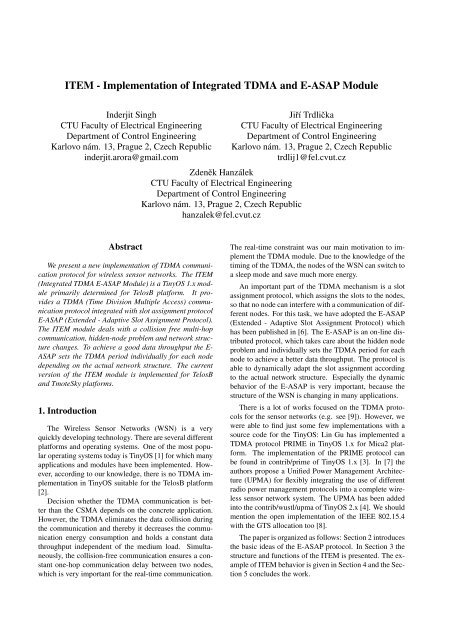ITEM - Implementation of Integrated TDMA and E-ASAP Module
ITEM - Implementation of Integrated TDMA and E-ASAP Module
ITEM - Implementation of Integrated TDMA and E-ASAP Module
You also want an ePaper? Increase the reach of your titles
YUMPU automatically turns print PDFs into web optimized ePapers that Google loves.
<strong>ITEM</strong> - <strong>Implementation</strong> <strong>of</strong> <strong>Integrated</strong> <strong>TDMA</strong> <strong>and</strong> E-<strong>ASAP</strong> <strong>Module</strong>Inderjit SinghCTU Faculty <strong>of</strong> Electrical EngineeringDepartment <strong>of</strong> Control EngineeringKarlovo nám. 13, Prague 2, Czech Republicinderjit.arora@gmail.comZdeněk HanzálekCTU Faculty <strong>of</strong> Electrical EngineeringDepartment <strong>of</strong> Control EngineeringKarlovo nám. 13, Prague 2, Czech Republichanzalek@fel.cvut.czJiří TrdličkaCTU Faculty <strong>of</strong> Electrical EngineeringDepartment <strong>of</strong> Control EngineeringKarlovo nám. 13, Prague 2, Czech Republictrdlij1@fel.cvut.czAbstractWe present a new implementation <strong>of</strong> <strong>TDMA</strong> communicationprotocol for wireless sensor networks. The <strong>ITEM</strong>(<strong>Integrated</strong> <strong>TDMA</strong> E-<strong>ASAP</strong> <strong>Module</strong>) is a TinyOS 1.x moduleprimarily determined for TelosB platform. It providesa <strong>TDMA</strong> (Time Division Multiple Access) communicationprotocol integrated with slot assignment protocolE-<strong>ASAP</strong> (Extended - Adaptive Slot Assignment Protocol).The <strong>ITEM</strong> module deals with a collision free multi-hopcommunication, hidden-node problem <strong>and</strong> network structurechanges. To achieve a good data throughput the E-<strong>ASAP</strong> sets the <strong>TDMA</strong> period individually for each nodedepending on the actual network structure. The currentversion <strong>of</strong> the <strong>ITEM</strong> module is implemented for TelosB<strong>and</strong> TmoteSky platforms.1. IntroductionThe Wireless Sensor Networks (WSN) is a veryquickly developing technology. There are several differentplatforms <strong>and</strong> operating systems. One <strong>of</strong> the most popularoperating systems today is TinyOS [1] for which manyapplications <strong>and</strong> modules have been implemented. However,according to our knowledge, there is no <strong>TDMA</strong> implementationin TinyOS suitable for the TelosB platform[2].Decision whether the <strong>TDMA</strong> communication is betterthan the CSMA depends on the concrete application.However, the <strong>TDMA</strong> eliminates the data collision duringthe communication <strong>and</strong> thereby it decreases the communicationenergy consumption <strong>and</strong> holds a constant datathroughput independent <strong>of</strong> the medium load. Simultaneously,the collision-free communication ensures a constantone-hop communication delay between two nodes,which is very important for the real-time communication.The real-time constraint was our main motivation to implementthe <strong>TDMA</strong> module. Due to the knowledge <strong>of</strong> thetiming <strong>of</strong> the <strong>TDMA</strong>, the nodes <strong>of</strong> the WSN can switch toa sleep mode <strong>and</strong> save much more energy.An important part <strong>of</strong> the <strong>TDMA</strong> mechanism is a slotassignment protocol, which assigns the slots to the nodes,so that no node can interfere with a communication <strong>of</strong> differentnodes. For this task, we have adopted the E-<strong>ASAP</strong>(Extended - Adaptive Slot Assignment Protocol) whichhas been published in [6]. The E-<strong>ASAP</strong> is an on-line distributedprotocol, which takes care about the hidden nodeproblem <strong>and</strong> individually sets the <strong>TDMA</strong> period for eachnode to achieve a better data throughput. The protocol isable to dynamically adapt the slot assignment accordingto the actual network structure. Especially the dynamicbehavior <strong>of</strong> the E-<strong>ASAP</strong> is very important, because thestructure <strong>of</strong> the WSN is changing in many applications.There is a lot <strong>of</strong> works focused on the <strong>TDMA</strong> protocolsfor the sensor networks (e.g. see [9]). However, wewere able to find just some few implementations with asource code for the TinyOS: Lin Gu has implemented a<strong>TDMA</strong> protocol PRIME in TinyOS 1.x for Mica2 platform.The implementation <strong>of</strong> the PRIME protocol canbe found in contrib/prime <strong>of</strong> TinyOS 1.x [3]. In [7] theauthors propose a Unified Power Management Architecture(UPMA) for flexibly integrating the use <strong>of</strong> differentradio power management protocols into a complete wirelesssensor network system. The UPMA has been addedinto the contrib/wustl/upma <strong>of</strong> TinyOS 2.x [4]. We shouldmention the open implementation <strong>of</strong> the IEEE 802.15.4with the GTS allocation too [8].The paper is organized as follows: Section 2 introducesthe basic ideas <strong>of</strong> the E-<strong>ASAP</strong> protocol. In Section 3 thestructure <strong>and</strong> functions <strong>of</strong> the <strong>ITEM</strong> is presented. The example<strong>of</strong> <strong>ITEM</strong> behavior is given in Section 4 <strong>and</strong> the Section5 concludes the work.
Own Neighbors Hidden nodesBFrame length: 8CDFrame length: 4ISlot(s) / Frame length2 / 8NodeDGISlot(s) / Frame length6 / 84 / 81 / 4NodeCFSlot(s) / Frame length1 / 85 / 8AHJ3 / 4GJEFANodeFigure 2: Information held in node H in Figure 1.NeighborsFigure 1: Example <strong>of</strong> a WSN.J(0) (1) (2) (3) (4) (5) (6) (7)I + C H J G F + I DJ2. E-<strong>ASAP</strong>In this section, we briefly introduce the E-<strong>ASAP</strong> (Extended- Adaptive Slot Assignment Protocol). For moredetailed description see [6].The <strong>TDMA</strong> protocol divides the usage <strong>of</strong> the communicationchannel into several non-overlapping slots, whichare repeated within some period. The number <strong>of</strong> slots inone period is called ”frame length”. The E-<strong>ASAP</strong> setsthe frame length <strong>of</strong> a new node (node joining the network)<strong>and</strong> assigns a free slot to this node. Eventually, if there isno free slot, the E-<strong>ASAP</strong> doubles the frame length <strong>of</strong> theinterested nodes.2.1. Frame FormatThe frame length is set as a power <strong>of</strong> two in E-<strong>ASAP</strong><strong>and</strong> the minimum frame length is fixed to four slots. Bysetting the frame length as a power <strong>of</strong> two, packet collisioncan be avoided between nodes with different framelengths. The first slot (slot zero) is reserved for a new nodeto transmit a request for doubling the frame length <strong>of</strong> itsneighbor nodes if its needed. An example <strong>of</strong> a <strong>TDMA</strong>frame is on Figure 3.2.2. Data FormatEach node maintains the information about the framelength <strong>and</strong> slots assignment <strong>of</strong> itself, its neighbors <strong>and</strong>its hidden nodes (nodes, which cannot communicate eachother <strong>and</strong> have a common neighbor). An example <strong>of</strong> informationheld by the node H in Figure 1 is shown on Figure2. The slot means the number <strong>of</strong> the assigned slot <strong>and</strong> theframe length means the number <strong>of</strong> slots in the <strong>TDMA</strong> period<strong>of</strong> the node. An example <strong>of</strong> the <strong>TDMA</strong> schedule inview <strong>of</strong> node H is shown on Figure 3. The slot zero is free<strong>and</strong> reserved for a new node. The letters in the slots denotethe nodes, which can send data in a given slot. Thereare assigned two nodes in slot number one. It is possible,because the transmission from node I <strong>and</strong> from node C donot interfere with each other.2.3. Packet FormatThere are two types <strong>of</strong> data packets in the E-<strong>ASAP</strong>.A data packet (DAT) <strong>and</strong> an information packet (INF).Figure 3: <strong>TDMA</strong> schedule in node H view in Figure 1.The DAT packet contains the information on the framelength <strong>of</strong> the sender, the current slot number, the maximumframe length among the sender <strong>and</strong> its neighbors<strong>and</strong> the transmitted data. The INF packet contains the informationabout the network structure in the node neighborhood.There is information about the frame length <strong>and</strong>the assigned slots <strong>of</strong> the sender <strong>and</strong> its neighbors. e.g. inFigure 1, the INF packet <strong>of</strong> node H contains the fist <strong>and</strong>the second table from Figure 2 (Own, Neighbors).2.4. Slot AssignmentThe newly joined node collects INFs transmitted by itsneighbors to obtain the slot assignment information. Aftersome period , the new node sets its frame length to fourslots (minimum frame length) <strong>and</strong> finds a free slot via thefollowing procedures:1. Getting an unassigned slotIf the first slot is not assigned to any neighbor, <strong>and</strong>there is an unassigned slot in the <strong>TDMA</strong> period (exceptthe first one), the new node assigns one <strong>of</strong> thefree slots to itself (except the first one).2. Doubling the frame lengthIf no slot is available in the current frame length, thenew node doubles the frame <strong>and</strong> tries again to assignan unassigned slot. This procedure is repeated untilthe new node finds an unassigned slot, or until themaximum allowed frame length is reached.After selecting a slot, the new node sends the INFpacket to its neighbors. The INF packet contains the informationabout itself <strong>and</strong> about the node neighbors.2.5. Releasing Slot AssignmentWhen a node exits from the network, it just stops sendingthe DAT <strong>and</strong> the INF packets. The neighbors detectdeparture <strong>of</strong> the node after some time when no DAT orINF packet has been received. Each neighbor changes itsassignment information <strong>and</strong> sends them by an INF packet.If possible, each node decreases its frame length.












